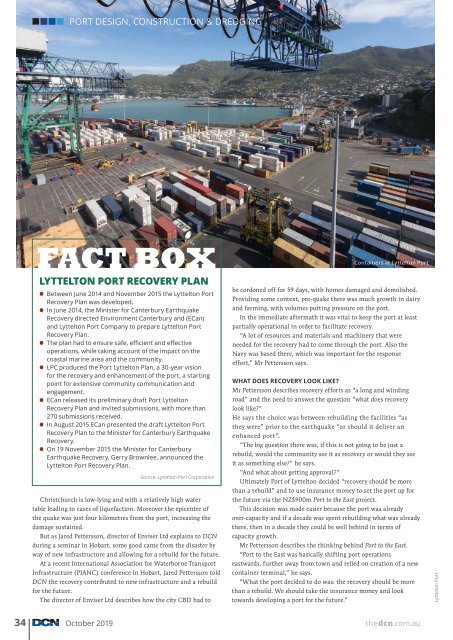DCN October Edition 2019
You also want an ePaper? Increase the reach of your titles
YUMPU automatically turns print PDFs into web optimized ePapers that Google loves.
PORT DESIGN, CONSTRUCTION & DREDGING<br />
FACT BOX<br />
LYTTELTON PORT RECOVERY PLAN<br />
•<br />
Recovery Plan was developed.<br />
•<br />
Between June 2014 and November 2015 the Lyttelton Port<br />
In June 2014, the Minister for Canterbury Earthquake<br />
Recovery directed Environment Canterbury and (ECan)<br />
and Lyttelton Port Company to prepare Lyttelton Port<br />
Recovery Plan.<br />
• The plan had to ensure safe, efficient and effective<br />
operations, while taking account of the impact on the<br />
coastal marine area and the community.<br />
• LPC produced the Port Lyttelton Plan, a 30-year vision<br />
for the recovery and enhancement of the port, a starting<br />
point for extensive community communication and<br />
engagement.<br />
• ECan released its preliminary draft Port Lyttelton<br />
Recovery Plan and invited submissions, with more than<br />
270 submissions received.<br />
• In August 2015 ECan presented the draft Lyttelton Port<br />
Recovery Plan to the Minister for Canterbury Earthquake<br />
Recovery.<br />
• On 19 November 2015 the Minister for Canterbury<br />
Earthquake Recovery, Gerry Brownlee, announced the<br />
Lyttelton Port Recovery Plan.<br />
Source: Lyttelton Port Corporation<br />
Christchurch is low-lying and with a relatively high water<br />
table leading to cases of liquefaction. Moreover the epicentre of<br />
the quake was just four kilometres from the port, increasing the<br />
damage sustained.<br />
But as Jared Pettersson, director of Enviser Ltd explains to <strong>DCN</strong><br />
during a seminar in Hobart, some good came from the disaster by<br />
way of new infrastructure and allowing for a rebuild for the future.<br />
At a recent International Association for Waterborne Transport<br />
Infrastructure (PIANC) conference in Hobart, Jared Pettersson told<br />
<strong>DCN</strong> the recovery contributed to new infrastructure and a rebuild<br />
for the future.<br />
The director of Enviser Ltd describes how the city CBD had to<br />
Containers at Lyttelton Port<br />
be cordoned off for 59 days, with homes damaged and demolished.<br />
Providing some context, pre-quake there was much growth in dairy<br />
and farming, with volumes putting pressure on the port.<br />
In the immediate aftermath it was vital to keep the port at least<br />
partially operational in order to facilitate recovery.<br />
“A lot of resources and materials and machinery that were<br />
needed for the recovery had to come through the port. Also the<br />
Navy was based there, which was important for the response<br />
effort,” Mr Pettersson says.<br />
WHAT DOES RECOVERY LOOK LIKE?<br />
Mr Pettersson describes recovery efforts as “a long and winding<br />
road” and the need to answer the question “what does recovery<br />
look like?”<br />
He says the choice was between rebuilding the facilities “as<br />
they were” prior to the earthquake “or should it deliver an<br />
enhanced port”.<br />
“The big question there was, if this is not going to be just a<br />
rebuild, would the community see it as recovery or would they see<br />
it as something else?” he says.<br />
“And what about getting approval?”<br />
Ultimately Port of Lyttelton decided “recovery should be more<br />
than a rebuild” and to use insurance money to set the port up for<br />
the future via the NZ$900m Port to the East project.<br />
This decision was made easier because the port was already<br />
over-capacity and if a decade was spent rebuilding what was already<br />
there, then in a decade they could be well behind in terms of<br />
capacity growth.<br />
Mr Pettersson describes the thinking behind Port to the East.<br />
“Port to the East was basically shifting port operations<br />
eastwards, further away from town and relied on creation of a new<br />
container terminal,” he says.<br />
“What the port decided to do was: the recovery should be more<br />
than a rebuild. We should take the insurance money and look<br />
towards developing a port for the future.”<br />
Lyttleton Port<br />
34 <strong>October</strong> <strong>2019</strong><br />
thedcn.com.au
















